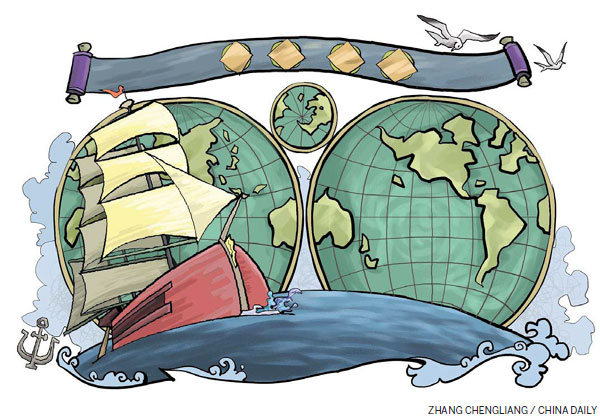Ranking China's global brand builders
As the Chinese economy continues its transition from low-cost production to high-quality premium brands, the new year began with the release of the first BrandZ Top 30 Chinese Brand Builders' ranking and report earlier this month.
This report is the result of groundbreaking, new research that provides tremendous insight into the brand-building progress made by Chinese companies in overseas markets. The research methodology focuses on overseas consumers' attitudes, beliefs and feelings toward Chinese brands. Chinese companies and China's image have been subjected to considerable investigative research over many years, but rarely have Chinese product and service brands been singled out with an in-depth, mainly qualitative research study.
In total, 167 established Chinese brands were included in the study, for which consumers were surveyed across seven of the world's most developed market economies: the United Kindom, France, Spain, Germany, the United States, Australia and Japan.
World-leading advertising and public relations agency WPP and global market research company Kantar Millward Brown collaborated with Google to produce the pioneering report.

The report's overall findings make for extremely encouraging reading for those Chinese brands hoping to continue their expansion deeper into overseas markets. More and more Chinese brands now enjoy increasing brand awareness levels.
But the report's most significant claim concludes that the circumstances are now very favorable for Chinese brands to build powerful brands based on their high quality and emotional connections with overseas consumers.
Lenovo, China's PC giant and the world's largest producer by sales volume, was named the most powerful Chinese global brand builder at present. This should come as no surprise, given Lenovo's clear commitment to international expansion ever since its audacious acquisition of the IBM PC brand well over 10 years ago.
Close behind Lenovo comes another consumer electronics brand success story in the shape of Huawei, China's giant multinational networking and telecommunications equipment and services company, headquartered in South China's city of Shenzhen, in Guangdong province. In recent years, Huawei has proven it can compete with even its fiercest rivals, such as Apple and Samsung. Huawei's acclaimed P9 smartphone provides demonstrable proof of the company's commitment to technological innovation, high quality standards, brand building and it is rumored that an even better model, the Huawei P10, could be launched very soon.
Chinese e-commerce giant Alibaba is ranked third, which should also come as no surprise, given its fairly recent listing on the US stock exchange.

Chinese consumer electronics brands represent a large share of the higher-ranked brands, with smartphone brand Xiaomi coming in at number 5, the third consumer electronics brand in the top 5.
The report finds that these higher-ranked brands now compete far less in price than they used to and have gained an enviable reputation for quality, reliability and service in the minds of overseas consumers.
But in addition to a cluster of strong consumer electronics brands, Chinese internet brands are also making more than a good name for themselves around the world and are seen by many overseas consumers as very competitively innovative.
The report does still present challenges facing Chinese brands in their quest for global recognition and relevance. Overseas consumers, despite growing acceptance of and trust in Chinese brands, reveal an almost habitual reach toward longer-established global brands, rather than the Chinese "new kids on the block". But even this habit appears to be waning, as Chinese brands prove themselves more and more and rely on price less and less.
It is also apparent from the report that consumer likelihood of purchasing a Chinese brand over an established, non-Chinese rival brand varies from country to country. In France, Germany and Spain, for instance, consumers appear far more likely to consume a Chinese brand, while Japanese, British and American consumers still hold stronger attachments to locally produced brands. Furthermore, geographical proximity can, at least partially, contribute to brand recognition.
There may also be some sort of "hangover" effect taking place, due to which American and Japanese consumers still hang on to the past, even the very recent past, when their countries were widely seen as technological pioneers. But now, according to the study, consumers are increasingly looking to China and Chinese companies for the latest technology breakthroughs, making now the most opportune time for Chinese brands to penetrate global markets. Gone is China's image of low prices and low quality in its products and brands.
This decline in negativity, which dogged Chinese brand building in the past, has also been matched by an increase in consumer involvement when deciding on brand consumption choice. The report finds that fame alone is no longer as significant a factor as it once was when consumers choose brands. Instead, a more rational, conscious and self-confident consumer now places tangible benefits and relevance higher.
This has helped Chinese brands compete with brands which have enjoyed international fame for far longer.
Harnessing the power of the internet also explains the international rise of many Chinese brands, such as Alibaba and Tencent. Chinese, internet-driven brands have shown that it is not necessary to initially focus on the domestic market to ensure steady growth, but that internet-driven innovation can allow a brand to explode on to the global scene with almost overnight success.
Despite a welter of positive findings, the report does also provide a sobering assessment of the challenges facing Chinese brands in increasingly competitive overseas markets. High among these challenges is the need for even more creativity and innovation, perhaps not in the use of the latest technology, but in brands' marketing initiatives. Innovation in technology is an absolute necessity on today's global battle of the brands, but it is not on its own sufficient. Brands have to build on this very tangible form of growth with layer upon layer of emotional meaning that resonates with consumers' increasing need for emotionally-fulfilling lifestyle experiences.
Creativity in all aspects of a brand's appearance and promotion is now the next hurdle for Chinese companies to overcome. But even here, there are encouraging signs, with Chinese companies such as Huawei investing heavily in sports and entertainment sponsorships to build emotional connections with overseas consumers, augmenting its reputation for quality and service.
So what could this all mean for European businesses? Should Chinese brands be seen as friend or foe? At a glance, the answer to this question may appear to be the latter, but looking into the question further should yield a different conclusion. This is good news for European industries in which the rise of Chinese brands internationally represents many substantial opportunities.
Chinese brands will now be seeking more long-term cooperation with European partners all along the supply chain, for example. European brands can also now see their Chinese competitors as an opportunity to learn from their technological excellence, in particular.
The idea that the rise of Chinese brands internationally poses a significant threat should be dispelled when pinpointing the sources of Chinese brands' success. It was, and still is, the firm presence of Western brands across the China mainland that initiated this brand-building path. Chinese companies learned extensively from these newly arrived Western brands and were spurred on to become even more competitive than their established Western rivals.
If Chinese brands can rise to the arrival of Western brands in China, then surely European brands can do likewise now that more and more Chinese brands have arrived in their backyard.
The author is a visiting professor at the University of International Business and Economics in Beijing and a senior lecturer at Southampton University. The views do not necessarily reflect those of China Daily.
(China Daily European Weekly 01/27/2017 page10)


















